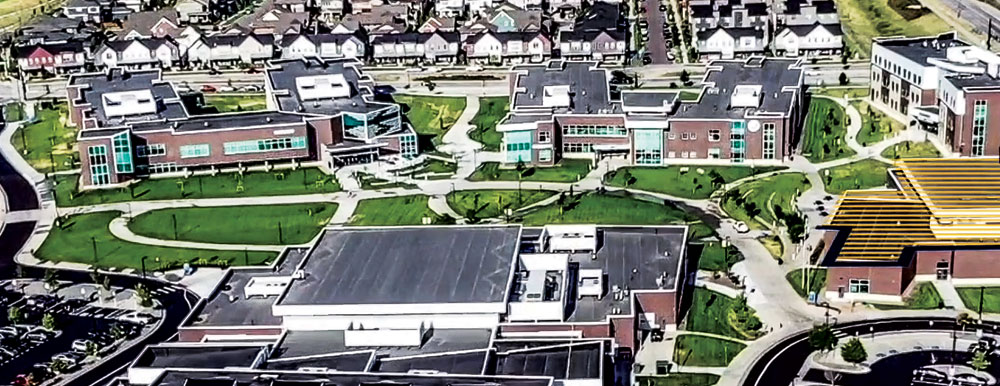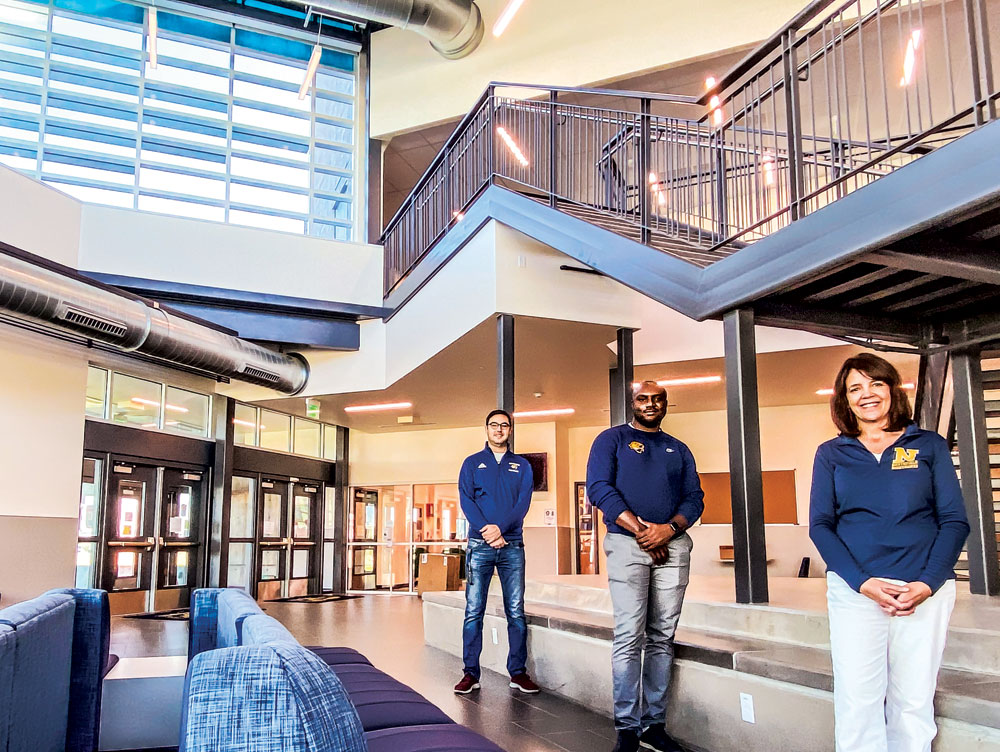
The campus, which was completed this year, includes: five buildings, a quad for outdoor gatherings, eight tennis courts, pickleball courts, two large soccer/football/lacrosse fields, three full-size basketball courts, a softball field, and a baseball field. The Performing Arts Center includes a theatre with a music classroom, rehearsal spaces, and a stagecraft workshop for building sets. Photo courtesy of Northfield High School
Five years ago, Northfield High School was just a vision. The idea was to create an inclusive, diverse, International Baccalaureate-for-all school that would close the achievement gap.
It was a lofty goal, and the challenges were many beginning with recruiting kids to a campus that had yet to break ground. There were also competing ideas of what the school would look like, financial woes, and changes in leadership. It was a rocky start, and so much of their success seemed to hinge on their ability to create community. Ezekiel Ocansey, a dean and head basketball coach, stresses that community is built on relationships. He remembers when the school first opened, and he started each day by shaking hands or high-fiving each and every student. “I want the kids to see me as a normal person who’s there to support them. So I have to be transparent about who I am from a professional and relatable perspective. I may or may not look like you, but if we share our experiences, we can learn from each other.”

Front to back, Principal Amy Bringedahl, Dean and Basketball Coach Ezekiel Ocansey, and IB Coordinator Peter Wright are pictured in the newly completed building #5. Front Porch photo by Christie Gosch
Gone are the days of handshakes and high-fives. Still, Principal Amy Bringedahl, says, “Northfield is a true community.” And by any standards, they’ve come a long way. They’re up to 1,225 students, up 300 from last year, with an eventual goal capacity of 2,500. They’ve also completed their sprawling five-building, college-like campus including a brand new performing arts center and expansive athletic facilities. They currently offer 20 CHSAA certified sports and plan to add field hockey and wrestling in the near future.
On the academic front, IB Coordinator, Peter Wright, who, like Ocansey, has been around since the school’s conception, talks with ease about how they approach student success. “We understand that the gap isn’t usually a product of will; it’s a product of social forces that are shaping opportunities that kids have access to, but we have a lot of data to show that when we get students of color and other marginalized students into the program, they’re finding a lot of success. In our first two cohorts—the classes of 2019 and 2020—the kids who did the full IB diploma more or less represented the larger demographics of those classes…half were students of color.” They also boast an 84 percent pass rate in IB Lang. and Lit. which means all Northfield graduates can go to college with some credit.

Building #5 brought new science and technology labs and lab equipment, along with small group work rooms and gathering areas for students. Photo courtesy of Northfield High School
Still, with growth comes new goals and new challenges. Bringedahl says she eventually wants 100 percent of students in the full IB Diploma Program. “I would like us to get to the point of asking students, ‘Why would you not take the full IB Diploma Program?’” She also aims to see 100 percent on-time graduation rates and stresses that she’s there for the long haul. “I am not ready to leave; we have more work to do to serve our community.” One of Wright’s main concerns is with gentrification; the DPS Board’s policy of recruiting 35 percent of the student body from the Far Northeast no longer guarantees a diverse population. “If you look at the demographics of the classes, our IB diploma cohorts are somewhat less representative [than they used to be], which I am definitely concerned about. One way you can measure [success] is whether students get the diploma or not. By that metric, the current junior and seniors are less diverse. But another metric is a lot of students don’t do the full IB diploma but go beyond the required two courses. If you look at the average number of IB classes that students are taking, including students of color, the average has gone up for the last three years.”

Northfield students performed The Canterbury Tales or Geoffrey Chaucer’s Flying Circus in November 2018.
When Wright’s done rattling data points off the top of his head, he’s quick to tell you that’s not really how he measures success anyway. When asked about a big win, he talked about a student who failed to earn her diploma. “Her mother was deported, and she went back over the holidays to see her mom, so she missed two months of school during her senior year. In May, she took all her IB exams and missed earning her diploma by one point, and I remember reaching out to her and dreading the conversation because here was a kid who worked so hard, and faced so much adversity, and did everything right, and she said, ‘It’s okay; it was still worth it.’ That would have crushed some kids, so to hear her say ‘even though I didn’t get this credential, the experience made me a better person and made me more prepared.’ And then to see this student go off to Boulder and thrive [and understand that] yes the credential is important but [it’s really about] the preparedness for college, career, all aspects of life, that’s what we’re in it for as educators.”



LOA Architecture is very proud to have been selected by DPS to provide the initial Master Plan design along with every building that is on the Paul Sandoval Campus.